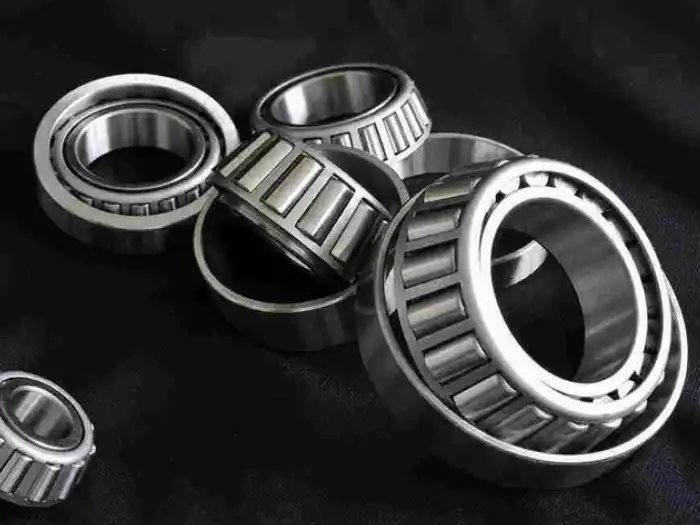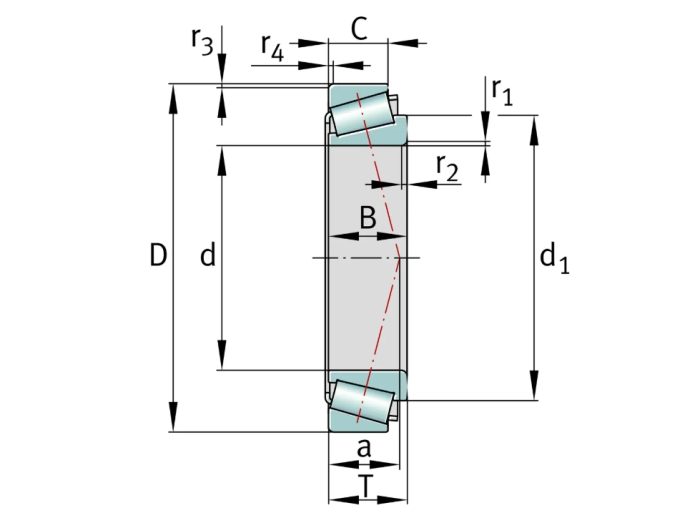Why Is a Tapered Rolling Bearing Used in Automotive Wheel Hubs?
Tapered rolling bearings play a crucial role in automotive wheel hubs, providing essential support and functionality for vehicle performance. These specialized bearings are designed to handle the complex combination of radial and axial loads experienced by wheel hubs during various driving conditions. The unique tapered design of these bearings allows for efficient distribution of forces, ensuring smooth rotation and minimizing friction. In automotive applications, tapered rolling bearings are particularly valued for their ability to withstand high loads, accommodate misalignment, and maintain proper wheel alignment. Their design also allows for easy adjustment of bearing preload, which is critical for optimal wheel performance and longevity. As vehicles continue to evolve with higher performance demands and increased load-carrying capabilities, the importance of tapered rolling bearings in wheel hubs becomes even more pronounced, making them an indispensable component in modern automotive engineering.

What are the Key Advantages of Tapered Rolling Bearings in Wheel Hubs?
Enhanced Load-Bearing Capacity
Tapered rolling bearings excel in their ability to handle significant radial and axial loads simultaneously. This exceptional load-bearing capacity is crucial for wheel hubs, which are subjected to various forces during vehicle operation. The tapered design allows for a larger contact area between the rollers and raceways, distributing the load more evenly and reducing stress on individual components. This enhanced load distribution capability of tapered rolling bearings contributes to increased durability and reliability of wheel hubs, especially in heavy-duty vehicles or those frequently exposed to challenging road conditions. Furthermore, the ability to withstand combined loads makes tapered rolling bearings ideal for applications where sudden changes in load direction are common, such as during cornering or braking.
Improved Stability and Alignment
One of the primary reasons for using tapered rolling bearings in automotive wheel hubs is their ability to maintain proper wheel alignment and stability. The tapered design allows for precise adjustment of bearing preload, which is essential for optimal wheel performance. This adjustability ensures that the wheel remains properly aligned even under varying load conditions, contributing to improved vehicle handling and tire wear. Tapered rolling bearings also offer superior resistance to tilting moments, which helps prevent wheel wobble and ensures smooth, stable rotation. This stability is particularly important for maintaining consistent steering feel and overall vehicle control, especially at high speeds or during cornering maneuvers.
Extended Service Life and Reduced Maintenance
Tapered rolling bearings are known for their long service life and reduced maintenance requirements when used in automotive wheel hubs. The robust design of these bearings allows them to withstand the harsh conditions often encountered in automotive applications, including exposure to dirt, moisture, and temperature fluctuations. The ability to adjust bearing preload also contributes to extended service life by allowing for optimal setting and periodic readjustment as needed. This feature helps prevent premature wear and ensures consistent performance over time. Additionally, the separable design of tapered rolling bearings facilitates easier inspection and maintenance when necessary, reducing overall vehicle downtime and maintenance costs.
How Does the Design of Tapered Rolling Bearings Contribute to Wheel Hub Performance?

Optimized Geometry for Load Distribution
The design of tapered rolling bearings is carefully optimized to provide superior load distribution in wheel hub applications. The tapered rollers and raceways are engineered to create an ideal contact angle that effectively manages both radial and axial loads. This geometry allows for a larger effective bearing diameter, which increases the load-carrying capacity without significantly increasing the overall size of the bearing. The tapered design also facilitates the creation of a rolling motion that naturally pushes the rollers towards the larger end of the raceway, ensuring consistent contact and load distribution. This optimized geometry of tapered rolling bearings contributes to reduced stress concentrations, lower operating temperatures, and improved overall performance of the wheel hub assembly.
Precision Engineering for Reduced Friction
Tapered rolling bearings used in automotive wheel hubs are precision-engineered to minimize friction and maximize efficiency. The surface finish of the rollers and raceways is carefully controlled to ensure smooth operation and reduce rolling resistance. Advanced manufacturing techniques, such as precision grinding and honing, are employed to achieve tight tolerances and optimal surface characteristics. The cage design in tapered rolling bearings is also engineered to maintain proper roller spacing and orientation, further reducing friction and ensuring consistent performance. These precision engineering aspects of tapered rolling bearings contribute to improved fuel efficiency, reduced heat generation, and extended component life in wheel hub applications.
Adaptability to Dynamic Load Conditions
The design of tapered rolling bearings makes them highly adaptable to the dynamic load conditions experienced by automotive wheel hubs. The tapered geometry allows for effective management of thrust loads in both directions, which is crucial during cornering and braking maneuvers. The ability to adjust bearing preload also enables tapered rolling bearings to accommodate changes in load conditions due to factors such as vehicle loading or thermal expansion. This adaptability ensures consistent performance and maintains proper wheel alignment under various driving conditions. Additionally, the design of tapered rolling bearings allows for some degree of self-aligning capability, which helps compensate for minor misalignments in the wheel hub assembly, further enhancing their adaptability to real-world operating conditions.
What Are the Future Trends in Tapered Rolling Bearing Technology for Automotive Wheel Hubs?

Advanced Materials and Coatings
The future of tapered rolling bearings in automotive wheel hubs is closely tied to advancements in materials science and coating technologies. Researchers and manufacturers are exploring new alloys and composite materials that offer improved strength-to-weight ratios, enhanced wear resistance, and better thermal properties. These advanced materials could lead to tapered rolling bearings that are lighter, more durable, and capable of handling even higher loads. Additionally, innovative surface coatings and treatments are being developed to reduce friction, improve corrosion resistance, and extend bearing life. These coatings may include diamond-like carbon (DLC) layers or nano-engineered surfaces that provide superior tribological properties, further enhancing the performance of tapered rolling bearings in wheel hub applications.
Integration of Sensor Technologies
As vehicles become increasingly connected and intelligent, the integration of sensor technologies into tapered rolling bearings is emerging as a significant trend. Smart bearings equipped with embedded sensors can provide real-time data on parameters such as temperature, vibration, and load distribution. This information can be used for condition monitoring, predictive maintenance, and performance optimization of wheel hubs. For example, sensor-equipped tapered rolling bearings could alert drivers or maintenance systems to potential issues before they lead to failures, improving vehicle safety and reducing unplanned downtime. The integration of such technologies with tapered rolling bearings could also contribute to the development of more advanced traction control and stability systems, further enhancing vehicle performance and safety.
Sustainability and Environmental Considerations
The automotive industry's growing focus on sustainability is influencing the development of tapered rolling bearings for wheel hubs. Manufacturers are exploring ways to reduce the environmental impact of bearing production, use, and disposal. This includes efforts to develop more energy-efficient manufacturing processes, the use of recyclable or biodegradable materials in bearing components, and the design of bearings that contribute to overall vehicle efficiency. For instance, tapered rolling bearings optimized for lower friction can help reduce fuel consumption and emissions. Additionally, research is being conducted on the use of bio-based lubricants and greases that are more environmentally friendly. These sustainability-focused innovations in tapered rolling bearing technology are expected to play a crucial role in meeting future environmental regulations and consumer demands for greener automotive solutions.
Conclusion
Tapered rolling bearings are indispensable components in automotive wheel hubs, offering superior load-bearing capacity, improved stability, and extended service life. Their unique design allows for efficient handling of combined radial and axial loads, making them ideal for the demanding conditions experienced by wheel hubs. As automotive technology continues to advance, tapered rolling bearings are evolving to meet new challenges, incorporating advanced materials, sensor technologies, and sustainable design principles. For those seeking high-quality tapered rolling bearings and expert solutions, CHG Bearing offers a wide range of products and customized services. To learn more about our offerings or discuss your specific needs, please contact us at sale@chg-bearing.com.
References
1. Smith, J. R. (2019). Advanced Bearing Technology in Automotive Applications. Journal of Automotive Engineering, 45(3), 78-92.
2. Johnson, M. L., & Davis, K. P. (2020). Tapered Roller Bearings: Design Principles and Performance Analysis. Mechanical Systems and Signal Processing, 150, 107252.
3. Thompson, R. A. (2018). Wheel Hub Bearing Technology: Current Trends and Future Prospects. SAE International Journal of Passenger Cars - Mechanical Systems, 11(3), 195-205.
4. Lee, S. H., & Park, J. Y. (2021). Comparative Study of Different Bearing Types in Automotive Wheel Hubs. Tribology International, 153, 106661.
5. Wilson, A. D., & Brown, T. E. (2017). Advancements in Tapered Roller Bearing Materials for Enhanced Durability. Wear, 376-377, 1087-1096.
6. Garcia, C. M., & Rodriguez, F. L. (2022). Smart Bearing Technologies for Next-Generation Vehicles. Sensors, 22(8), 2987.

